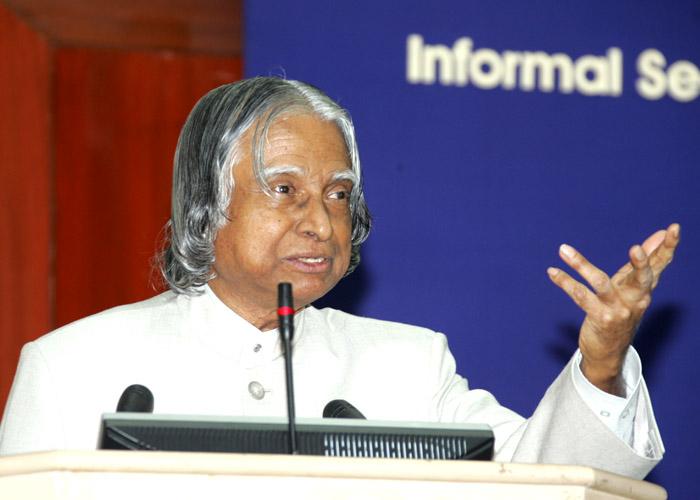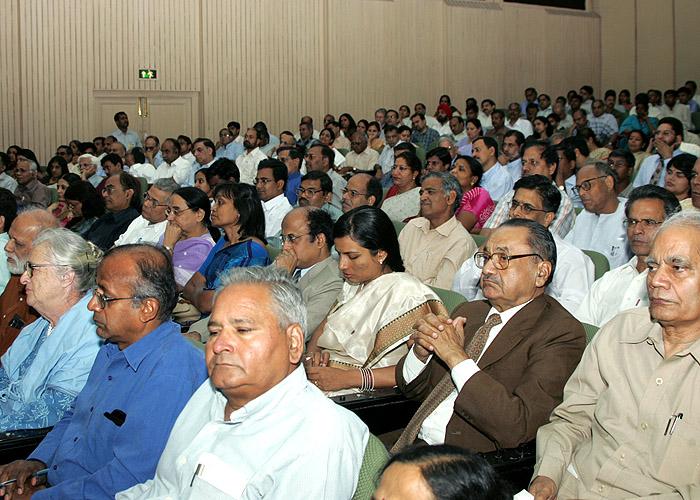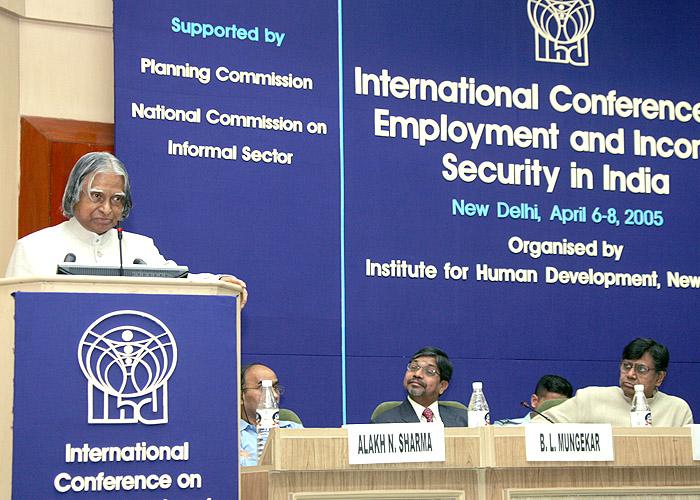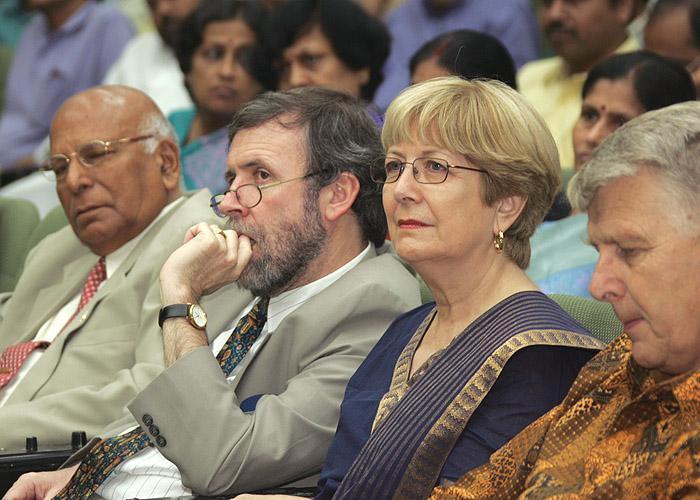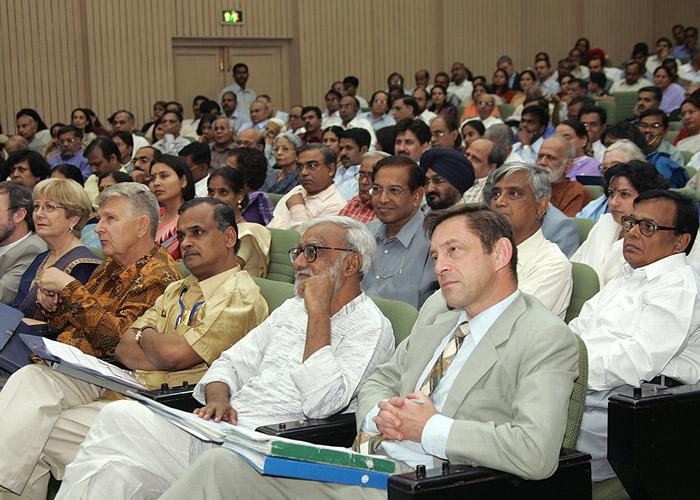Address at the International Seminar on Income and Employment Security in India
New Delhi : 06-04-2005
Employment Generator and Employment Potential
I am delighted to participate in the International Seminar on Income and Employment Security in India organized by the Institute for Human Development in collaboration with International Labour Organisation, Planning Commission, National Commission on Informal Sector and Ford Foundation and deliver the inaugural address. My greetings to the organizers, government functionaries, planners, HRD specialists, non-Government organisations, trade unions, international organisations and academicians participating in this Seminar. I would like to discuss on the topic 'Employment Generator and Employment Potential'.
Law of development
I was studying the development patterns and the dynamics of connectivity between nations, especially in trade and business. As you all know the world has few developed countries and many developing countries. What is the dynamics between them and what connects them? Developed country has to market their products in a competitive way to different countries to remain as developed country. The developing country, (if the nation has the vision) to get transformed into developed country; they too have to market their products to other countries in a competitive way. Competitiveness is the scaling factor for both type of nations. Competitiveness has three dimensions: quality of the product, cost effectiveness and supply in time. Indeed this dynamics of competitiveness in marketing of products by developing and developed countries is called the law of development. Competitiveness comes from technology, administration, management, work environment and employee productivity. India is ranked 56 in terms of Growth Competitive Index and 127 in terms of Human Development Index. We have to work together to become 10 in the Growth Competitive Index and 20 in Human Development Index.
Adding value to education through Entrepreneurship
There has been substantial growth in our higher educational system and we are generating over 3 million graduates every year and over seven million plus two level candidates who are aspiring for employment. However our employment generation system is not in a position to absorb all these youth leading to increase in educated unemployed, year after year. This situation will lead to instability in the social structure. We need higher education backed by employment opportunities. A multi pronged strategy is needed to make education more attractive and simultaneously create employment potential - how do we do that?
Firstly, the educational system should inculcate by adding syllabus of entrepreneurship and prepare the students right from the school and college education to get oriented towards setting up of the enterprises which will provide them creativity, freedom and ability to generate wealth. Apart from entrepreneurship, the youth should have the spirit that "we can do it". Secondly, the banking system should provide venture capital right from every village level to the prospective entrepreneurs for undertaking new enterprises. Banks have to be proactive to support the innovative products for enabling wealth generation by young entrepreneurs. Thirdly, there is a need to identify marketable products and enhancement of purchasing power among the people. This can come through the implementation of mega programmes such as PURA, Interlinking of Rivers, Infrastructural missions, Power missions and Tourism. The universities and schools should become a facilitator for creating this entrepreneurship scheme through the support of the banking system and the marketing system. This will enhance value to the education and create the motivation for the students.
National Employment Status
As per the estimate of the Planning Commission, the total number of people eligible for employment at present is approximately 400 million. Out of this, nine percent are unemployed which works out to around 36 million. In addition, there is a need to find value added employment for 10% of those employed in the agriculture sector in the rural areas. Our attempt hence should be to find gainful employment for around 76 million people. What are the actions needed to generate employment for 56 million people. This will add to our productivity and will ensure a sustained 10% GDP growth for the decade, which is an essential need for India to become a developed country before 2020.
Employment generators
Let me share with you how to generate employment. The most important sectors for sustainable national development are Agriculture, Education, Healthcare, Water and Energy. The common thread that will run across these would be the three connectivities of PURA namely physical connectivity, electronic connectivity and knowledge connectivity. These three connectivities will lead to economic connectivity. One of the ways by which the rural agriculturists could increase their earnings is by value adding to the agricultural produce by processing and manufacturing. The farmers, either individually or through their co-operatives would market processed and value added items instead of marketing the raw materials. This increase in the value-addition taking place in the rural area itself is an indicator of the society moving towards prosperity and knowledge era. I would like to suggest eight schemes that can bring large-scale employment and prosperity to our people in the rural sector.
1. Bio-fuel generation
We have nearly 63 million hectares of wasteland available in the country, out of which 33 million hectares of wasteland have been allotted for tree plantation. Certain multi-purpose bio-fuel plants can grow well in wasteland with very minimum input. Once cultivated, the crop has fifty years of life. Fruiting can take place in these plants in two years.
Bio-fuel plants grown in parts of the waste land, for example, 11 million hectares, can yield a revenue of approximately Rs. 20,000 crore a year and provide employment to over 12 million people both for plantation and running of the extraction plants. It will reduce the foreign exchange outflow paid for importing crude oil, the cost of which is continuously rising in the international market. The Bio-fuel is Carbon mono-oxide emission free. The oil can also be used for soap and in candle industries. De-oiled cake is a raw material for composting and the plantation is also good for honey production. We should absorb best of the technologies available worldwide and start commercial operation immediately. One time investment needed for bio-fuel plantation to production in 11 million hectares will be approximately Rs. 27000 Crores. The capital equipment and investment in plant and machinery can come from bank loans and private sector entrepreneurs. I have seen the progress in bio-fuel plant cultivation, preparation of seedlings, tissue culture and development of non-toxic hybrid varieties in Tamil Nadu Agricultural University, Coimbatore. They have also worked from processing of seeds to bio-fuel production by the indigenous design and development of bio-fuel plants. Anand Agriculture University at, Anand (Gujarat) has also made progress in the bio-fuel cultivation and processing in Gujarat. Bio-fuel plants can be grown in a number of states in the southern, western and central part of the country.
2. Waste Land Development
opportunities ICRISAT with its international experience of working in arid regions, have developed short duration, disease and drought resistant varieties of important crops beneficial to our farmers. They have introduced various tillage practices and nutrition management techniques, to boost crop yields even under drought stress. This technology will enable us to reclaim 5 more million hectares of the 33 million hectare of wasteland allotted for productive farming. As per the experts, this will result in the deployment of 15 million people for the dry land cultivation.
3. Water Harvesting
Water harvesting should become mandatory for all. To improve water table, we need to build check dams, develop water sheds, desilt ponds and rivers, clear the inlets and outlets to the ponds and water bodies and recharge the wells. If our rural areas are made to have the operational water bodies, recharging of the wells will take place. The task is totally labour intensive and nation wide implementation of this scheme will provide employment for six million persons for more than three or four years. Even after this period many people will be required to maintain water bodies, produce clean water and arrange supply. The scheme will result in increase in storage capacity of water bodies and create additional irrigation potential of the land in the region and enhance agricultural productivity.
4. Bamboo Mission
This mission envisages an integrated programme of expansion of plantations of Bamboo species, the scientific management, and promotion of community level value addition and entrepreneurship. This will enable presenting the raw material for the industries and the industry to access and apply modern technology for producing globally competitive new generation bamboo products. This includes setting up of clusters of small value addition processing units, near the resource for employment generation and benefit to the local small entrepreneur. Processed raw material suitable for ultimate use in industry / handicraft sector will be required, for economizing handling cost of raw material to the location of industry proposed to be set up in different parts of the country.
The programme envisages the cultivation of bamboo over two million hectares and promotion of technology and networking for enhancing the trade. The economic and social benefit from these activities, will lead to the creation of 8.6 million jobs and the market opportunities worth over Rs. 6,500 crore with an investment of Rs. 2600 crore. This will be useful for the additional development of the north-eastern region. We should use the management personnel, industrial experts and business houses to provide international market connectivity for our bamboo products leading to sustainable growth, wealth generation and positive contribution to the growth of GDP. The institutions like National Institute of Design, Ahmedabad, Indian Institutes of Management, Industrial houses, State government and Ministry of Agriculture can work together to generate number of Bamboo enterprises in different rural clusters.
5. Converting the fly ash as Wealth Generator
As you are aware, the use of coal for power generation results in increased quantum of fly ash production, which has reached about 100 million tonnes per year. All out efforts are needed to utilize this fly ash not only from environmental considerations, but also to avoid land usage for fly ash dumping. Though there has been a steady progress in fly ash utilization from 1990, we have a long way to go to reach the target of 100% fly ash utilization. It is reported that the agricultural increase of grains is around 15%, green vegetables 35% and root vegetables 50%, when fly ash is mixed with the soil. Toxicity tests have proved that there is no toxic element due to fly ash. But it has higher nutrients due to increased availability of iron and calcium. The fly ash can become a wealth generator by making use of it for producing "green building" materials, road, agriculture etc. Presently, the fly ash utilization is in the range of 33 million tones per year and providing employment for over 50,000 personnel. For full utilization of the generating stock, will provide employment potential for three hundred thousand people and result in a business volume of over Rs. 4000 crore.
6. Textile industry
Textile industry is very important for the Indian economy. The basic raw material is cotton. India is the third largest producer of cotton in the world. However, compared to the world average of 700 kgs of seed cotton per acre we produce only 350 kgs of seed cotton per acre. It is indeed a technological concern for the nation. Some of the industries have adopted a village in Punjab, which has brought out a cooperative movement of the farmers, scientists, trainers and the industry and launched for cultivating cotton in over 1200 acres. A training programme was launched for farmers starting with soil characterization, matching the cottonseed to soil, water and fertilizer management.
The project resulted in increasing the average seed cotton yield of the village from 450 KG per acre to 950 KG per acre. This led to the seven-fold increase in net return per acre, due to considerable reduction in input costs. It is worth noting that in this case the yield is above the world average. This model has already been replicated in ten villages and can be emulated by many cotton-growing regions of the country. India can definitely produce 25% of the total world production of quality cotton compared to the existing 12% leading to revenue of over Rs. 25000 crores a year for the nation. The Chairman for Standing Committee on Cotton - Indian Cotton Mills Federation has said this is a feasible proposition and they are working to implement it enthusiastically in partnership with the farmers.
I would like to link cotton production to garment export business, which is a low investment and large volume employment generator. India is presently, exporting six billion dollars worth of garments, whereas with the WTO regime in place, we can increase the production and export of garments to 18 to 20 billion dollars within the next five years. This will enable, generation of employment in general and in rural areas in particular. By tripling the export of apparels, we can add more than 5 million direct jobs and 7 million indirect jobs in allied sector, primarily in the cultivation of cotton. Concerted effort is needed in Cotton research, technology generation, transfer of technology, modernization and upgrading of ginning and pressing factories and aggressive marketing strategy.
7. Healthcare
Another area, which is an employment generator, is the health care industry. We have only one doctor for one thousand eight hundred people, whereas in some of the developed countries the doctor to population ratio is 1: 600. For providing quality health care to all of our citizens, we would need at least doubling the strength of doctors and paramedical staff in the whole country. The investment for this, need not necessarily come from government alone. Hospitals can be setup by the private sector with certain tax concessions and subsidized infrastructural support.
Setting up of 30,000 static tele-medicine stations distributed in 30,000 key locations, within the zone of 3 lakh villages and providing 20,000 mobile tele-medicine units will enable reaching of quality healthcare closer to every home, which are connected to the district, state government hospitals, corporate hospitals, super specialty hospitals in the country. This is possible as India has a network of satellite communication.
How to reach healthcare for the large number of our population? An innovative method has come into action in certain states. This system provides free health cover to the citizens who are members and pay Rs. 10 per individual per month as an insurance premium. State and Central Government can sponsor this insurance scheme involving payment of a small premium of Rs. 10 per individual per month by the citizens in different states of the country. Such an insurance cover should be able to provide for all types of diseases including expensive open heart surgery. A consortium is required to be formed, in different states between the Government, insurance agencies, corporate hospitals and NGO?s for providing integrated cost effective health care. The scheme when fully operational, can provide direct employment for additional 600,000 doctors and 1.2 million paramedical staff. Apart from providing healthcare to citizens, these corporate hospitals can attract large number of medical tourists to the country in view of our competitiveness in treating complex diseases. I am very happy to know that the scientific community for health is working on anti HIV vaccine development, which is in an advanced stage of development. The success of this programme will be a breakthrough in containing the HIV virus.
8. Village Knowledge Centres
With the kind of awareness and opportunities available in ICT, it will soon become a reality wherein every one of our villages will have computers and connectivity available. These would be the window to the world of knowledge for our villages and also to reap the benefits of our e-governance, tele-education, tele-medicine, e-commerce and e-judiciary initiatives. In spite of the all pervasive nature of the computers they would still be far away from being a truly friendly access device for our villagers. We would need in such cases, a human intermediary who would act as the village information officer. He will be the extended eyes and ears of the villager to the world of knowledge. India has approximately 2.3 lakh Village Panchayats. I visualize establishment of village knowledge centers in these Panchayats to empower the villagers with the knowledge and to act as a nodal center for knowledge connectivity for the villagers. The knowledge center from which the villagers would access the information through the village information officer can also be used for collection, digital storage and dissemination of village specific information pertaining to any relevant information to the villagers. This will provide direct quality employment to over one million who will be instrumental in promoting higher level of wealth generation in our rural sector.
The eight schemes discussed so far, have the potential to generate approximately a total of 56 million direct employments during the next 5 years. The other employment avenues in the government and the private sectors based on core competence in areas such as marine products in coastal region, tourism in different states, enhanced employment in ICT sectors including knowledge products and the precision manufacturing sector has a great potential for creating additional productive employment.
Conclusion
For the nation today what is needed is a combination of technology, innovation, leadership and inspired workforce. Let us analyze the dynamics of good organizations for national development. Developed India as defined can be only powered by economic strength.
- The economic strength is powered by competitiveness
- The competitiveness is powered by knowledge power.
- The knowledge power is powered by Technology and innovation.
- The Technology and innovation is powered by resource investment.
- The Resource investment is powered by revenue and return on Investment.
- The Revenue is powered by Volume and repeat sales through customer loyalty.
- The customer loyalty is powered by Quality and value of products.
- Quality and value of products is powered by Employee Productivity and innovation.
- The Employee Productivity is powered by Employee Loyalty, employee satisfaction and working environment.
- The Working Environment is powered by management stewardship.
- Management stewardship is powered by Invisible leadership
The Invisible leadership means exercising the vision to change the traditional role from the commander to the coach, manager to mentor, from director to delegator and from one who demands respect to one who facilitates self respect. I am sure all the institutions and the future aspiring institutions are spearheaded by invisible leadership. For a prosperous and developed India, the important thrust will be on the growth in the number of Invisible Leaders and innovative organisations which can provide productive and wealth generating employment for all the youth of the nation.
My best wishes to the seminar participants for fruitful discussions on this vital issue leading to the provision of useful recommendations for the mission of providing income and productive employment.
May God bless you.

